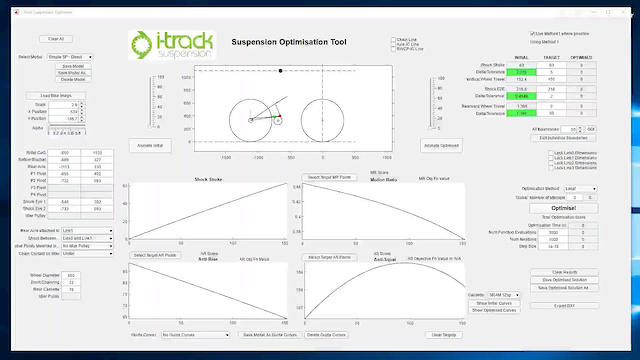i-track
- Member since Mar 12, 2019
-
 Adelaide , Australia
Adelaide , Australia - 2 Followers
- 0 Trailforks Points
Recent

i-track Mandownmedia's article
Aug 5, 2022 at 5:50
Aug 5, 2022
Bike Check: Joe Breeden's Intense M279 HP1 Prototype DH bike
Welcome back Joe!!

i-track edspratt's article
Jul 15, 2022 at 16:22
Jul 15, 2022
Qualifying Results from the Vallnord DH World Cup 2022
Yeah Aaron and Dak!!!

i-track edspratt's article
Mar 12, 2022 at 15:00
Mar 12, 2022
Final Results: Dakotah Norton & Kailey Skelton Win the 2022 Tennessee National DH
Looks like the Intense lads are feeling confident on their prototypes (with i-track suspension!). Congratulations to Dak for taking the win!

i-track ralf-hauser's article
Sep 15, 2021 at 16:21
Sep 15, 2021
Bike Check: Insanityofgravity's Titanium, Ultra High Pivot Freeride Bike
@Primoz: In THIS bike, the amount of chain wrapped on the top of the idler and on the cassette (around to the bottom of the cassette, directly above the wheel contact patch) will both vary as the suspension moves through its travel.
Please don’t dismiss the concentric pivot example as being irrelevant for this case. If you can understand the role of the rear chainline in the case of a concentric pivot idler, then you’ll see that it’s still relevant in THIS example.
Hope that helps.
Cheers, Hugh.

i-track ralf-hauser's article
Sep 15, 2021 at 4:13
Sep 15, 2021
Bike Check: Insanityofgravity's Titanium, Ultra High Pivot Freeride Bike
@Primoz:
It relates to the amount of chain that is wrapped/unwrapped from the casette and idler pulley as the suspension moves through its travel.
I realise this bike is a swingarm mounted idler, but the case of a concentric idler is a crucial boundary condition to assist with understanding the difference between the two configurations (idler mounted on front triangle vs idler mounted on swingarm).
With a concentric mounted idler, you can consider that the idler is mounted on the front triangle, therefore the 'conventional' graphical method is applicable (and correct). Despite there being no distancing between the idler and the cassette, this method still uses the chainline from the idler to cassette in the algorithm. If you change the sizes of the idler or cassette (or both) it affects the amount of wrap/unwrap of chain on these items as the suspension moves through its travel. This is reflected in the change in point where the chainline intersects the swingarm line, and therefore affects the anti-squat.

i-track ralf-hauser's article
Sep 13, 2021 at 15:28
Sep 13, 2021
Bike Check: Insanityofgravity's Titanium, Ultra High Pivot Freeride Bike
@justinfoil:
Just so you know, I wrote the algorithms that Linkage software uses to calculate AS for any configuration with the idler not on the front triangle.
Both chainlines (cassette to idler, idler to chainring) are required in the calculations.
Consider a high single pivot configuration, with the idler mounted concentric with the main pivot. Do you consider the idler as being attached to the swingarm or to the front triangle? (It’s both!) If the idler is considered as being on the front triangle, then you’ll get one value for AS. And by your logic, if the idler is considered as being mounted in the swingarm (infinitely close to the pivot), then you’d get a very different AS value.
Your suggested method fails at this boundary condition.
Lots of people use these graphical methods, but not many truly understand how it is developed.
Here’s some guidance. Consider a single pivot layout with a conventional drivetrain. When you intersect the chainline and the swingarm line, you’re actually locating the instant centre of the wheel wrt the suspended mass.
Knowing that, you can now consider the mechanism of a swingarm mounted idler, and work out how to locate the IC of the wheel wrt suspended mass for that configuration.
You’ll find that both chainlines are involved.
You’ll also find that this method gives the same result as the ‘normal’ method at the boundary condition when the idler is mounted concentric to the pivot.
Hope that helps.
Cheers,
Hugh McLeay

i-track ralf-hauser's article
Sep 13, 2021 at 5:27
Sep 13, 2021
Bike Check: Insanityofgravity's Titanium, Ultra High Pivot Freeride Bike
@Primoz: when the idler is mounted on the swingarm, both chainlines are involved in the AS calculation.

i-track DaveRome's article
May 8, 2021 at 3:21
May 8, 2021
Trinity MTB Debuts With a Steel, High Pivot, Gearbox Compatible Freeride Bike
Correct. Generating good amounts of AS with less chain growth is a characteristic of all 'high-pivot' bikes, not just i-track configurations. The higher the pivot (real or virtual), the more rearward the axle path, and the more AS that is generated by the axle path alone.
Unless the pivot is really high though, you still need some amount of chain growth to generate a bit more AS and get it into that 'pedals well' range. This is where i-Track becomes very useful; it provides the designer with many options for positioning the idler in a suitable location so that it moves in a way that generates the chain growth you need.

i-track DaveRome's article
May 8, 2021 at 2:10
May 8, 2021
Trinity MTB Debuts With a Steel, High Pivot, Gearbox Compatible Freeride Bike
It's fantastic to see this project come to life!
Congratulations to the team at Trinity for getting this prototype together against a tight schedule, with a couple of curve-balls thrown in along the way.
The i-Track suspension system is all about providing the designer with options for achieving their design goals. In this case, the high-pivot inverted Horst Link layout provides a rearward axle path without the increase in Anti-Rise (aka 'brake jack') that you would get with a high-single-pivot configuration. Having the idler 'floating' on the seatstay link means that the idler pulley can be positioned in a much more convenient location than it would have to be if it was 'fixed' on the front triangle. Additionally, by making small changes to the idler position (forwards or backwards on that seatstay member), Trinity has the power to test a huge range of Anti-Squat values, so they can arrive at a final product that meets all their expectations. Having the idler mounted in this way has provided flexibility for Trinity, and allowed them to package the suspension incredibly neatly.
Well done!

